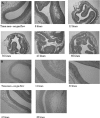Prevention of vessel desiccation and maintenance of normal morphology during endovascular harvesting using humidified warmed gas
- PMID: 22906324
- PMCID: PMC3407440
- DOI: 10.4293/108680812X13291597715745
Prevention of vessel desiccation and maintenance of normal morphology during endovascular harvesting using humidified warmed gas
Abstract
Background and objectives: Endoscopic vessel harvesting (EVH) traditionally uses carbon dioxide (CO(2)) gas for insufflation. The CO(2) based on government regulations is bone dry and room temperature. All previous EVH studies use this type of unconditioned gas. It is hypothesized that by changing the quality of CO(2) gas differences may occur that are attributable to dry gas versus wet gas exposure.
Methods: A comparison of the effect(s) of traditional dry CO(2) gas compared to humidified exposure was done using a porcine model and evaluated in a double-blind randomized controlled fashion.
Results: Vessels exposed to traditional dry cold gas had morphologic and structural changes noted on histologic evaluation. This included desiccation changes of the tunica adventitia desiccation and tunica media collagen and elastin. Vessels exposed to dry gas showed 10% to 12% contraction and constriction with tortuous changes to the intima and endothelial lining that were progressive with increasing volumes of gas exposure. No desiccation or morphologic changes were seen with humidified warmed gas produced using the VesselGuardian.
Conclusions: Traditional dry cold CO(2) caused vascular tissue damage extending from the adventitia to intima, changing the vessel in morphologic and structural configuration. With the VesselGuardian humidified warmed, gas maintained vessel morphology and integrity by preventing desiccation. Changing the quality of CO(2) from dry and cold to wet and warm may offer clinical utility for a better quality conduit for coronary artery bypass graft procedures.
Figures


Similar articles
-
Can wound desiccation be averted during cardiac surgery? An experimental study.Anesth Analg. 2005 Feb;100(2):315-320. doi: 10.1213/01.ANE.0000140243.97570.DE. Anesth Analg. 2005. PMID: 15673849
-
Improved outcomes for lap-banding using the Insuflow device compared with heated-only gas.JSLS. 2009 Jul-Sep;13(3):302-5. JSLS. 2009. PMID: 19793466 Free PMC article. Clinical Trial.
-
Warm humidified CO2 insufflation improves pericardial integrity for cardiac surgery: a randomized control study.J Cardiovasc Surg (Torino). 2022 Jun;63(3):369-375. doi: 10.23736/S0021-9509.22.12004-5. Epub 2022 Mar 28. J Cardiovasc Surg (Torino). 2022. PMID: 35343658 Clinical Trial.
-
Warmed and humidified carbon dioxide for abdominal laparoscopic surgery: meta-analysis of the current literature.Surg Endosc. 2017 Jan;31(1):1-12. doi: 10.1007/s00464-016-4866-1. Epub 2016 Mar 22. Surg Endosc. 2017. PMID: 27005288 Review.
-
Endoscopic radial artery harvesting with a non-sealed approach.Multimed Man Cardiothorac Surg. 2019 Apr 9;2019. doi: 10.1510/mmcts.2019.008. Multimed Man Cardiothorac Surg. 2019. PMID: 30990576 Review.
Cited by
-
Moisturization of the Surgical Field during Cancer Resection Reduces Perioperative Complications in Reconstruction Surgery.Plast Reconstr Surg Glob Open. 2022 May 2;10(5):e4296. doi: 10.1097/GOX.0000000000004296. eCollection 2022 May. Plast Reconstr Surg Glob Open. 2022. PMID: 35510224 Free PMC article.
References
-
- Ahmed S, Johansson B, Karlsson M, Souza D, Dashwood M, Loesch A. Human saphenous vein and coronary bypass surgery: ultrastructural aspects of conventional and “no-touch” vein graft preparations. Histol Histopathol. 2004;19:421–433 - PubMed
-
- United States Pharmacopeia and National Formulary and Supplements, XXI-NF, 1984
-
- Griffith G, Allen K, Waller B, et al. Endoscopic and traditional saphenous vein harvest: a histologic comparison. Ann Thorac Surg. 2000;69:520–523 - PubMed
-
- Zalewski A, Shi Y, Johnson AG. Diverse origin of intimal cells: smooth muscle cells, myofibroblasts, fibroblasts, and beyond? Circ Res. 2002;91:652–655 - PubMed
MeSH terms
Substances
LinkOut - more resources
Full Text Sources
